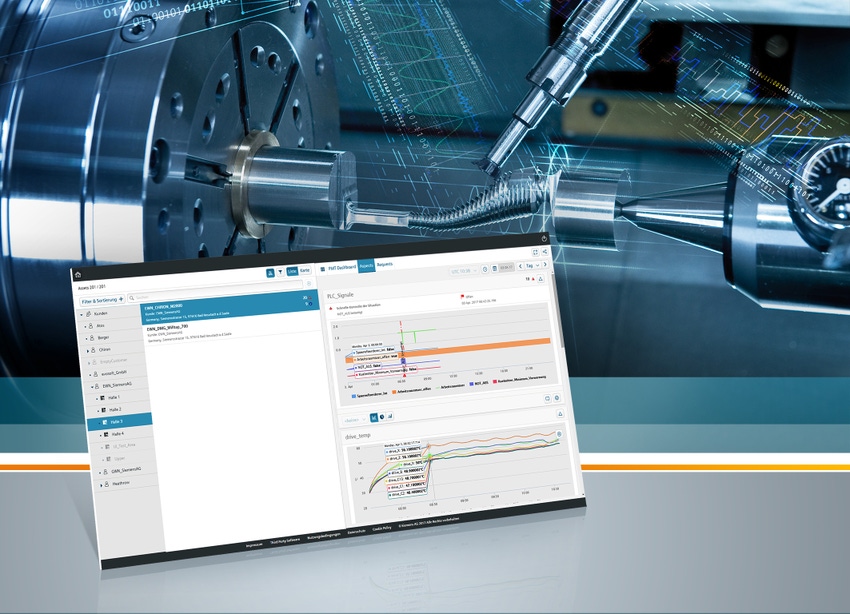Siemens Preaches Gospel of Manufacturing ‘Digitalization’
Automation giant's software platform aims to unite design, engineering, manufacturing.
August 15, 2017

Siemens AG continued its push this month to unite the design and manufacturing realms into a single data model, announcing it will soon add two more key software tools.
The automation giant said that in September it will unveil an application called Manage MyMachines for its MindSphere operating system, along with a separate software solution called Sinumerik Edge for analyzing data from machining processes. The products will serve as two more elements in Siemens’ effort to create an end-to-end software portfolio for companies seeking to “digitalize” their operations. By doing so, Siemens hopes to further close the loop between design and manufacturing, enabling manufacturers to more readily identify whether products are manufacturable before they reach the factory floor.
“Up to now, not everyone has had the ability to close that loop,” Sal Spada, research director for discrete automation at ARC Advisory Group, told Design News. “That’s a big part of their initiative – closing the loop from design down to the manufacturing processes. It’s the digitalization thread.”
|
In September, Siemens AG will unveil an application called Manage MyMachines for its MindSphere IoT operating system. (Source: Siemens AG) |
The Manage MyMachines product is the first application for Siemens’ MindSphere, an open IoT operating system that allows machine data to be sent to the cloud. Manage MyMachines would give operators an overview of the machine data, enabling them to optimize their production. Similarly, Sinumerik Edge would allow operators to process machine data, but to do so at the machine, without sending it to the cloud. Siemens announced the two new products at a press event in Chicago last week.
The two products are the latest entries in Siemens’ ongoing effort to create a “digitalization” platform that encompasses product design, product planning, production engineering, production execution and services. That effort began a decade ago, when Siemens acquired UGS Corp., a provider of product lifecycle management software and services. It then acquired LMS International NV, a supplier of test and mechatronic simulation software, in 2012, followed by CD-adapco, a maker of simulation software, in 2016, and EDA software maker, Mentor Graphics, in 2017. In all, Siemens has invested $10 billion in acquisitions since 2007 and $5 billion in R&D expenditures during that time.
Siemens digitalization effort has value for design engineers in that it enables them to create a “digital twin” of their product, production process, and manufacturing equipment. “That’s huge,” said Spada of ARC Advisiory Group. “If you can’t manufacture something cost effectively, then you can go back to the design before you get to physical manufacturing and redesign it.” The company’s digitalization technology will be especially well suited to automotive and avionics manufacturing – two areas where Siemens is already strong, Spada said.
To be sure, Siemens isn’t the first to offer many of the products in its digital process chain. It is, however, believed to be the first to provide an end-to-end solution on a common platform. “Up to now, manufacturers have used many different tools,” Raj Batra, president of Siemens Digital Factory Division, told Design News last week. “It’s been more bolted-on, rather than integrated and holistic.” Using Siemens end-to-end solution addresses that problem, he said.
Batra added that it’s often said that 80% of a part’s manufacturing costs are pre-determined during design. “That’s why you need to look at this holistically,” he said. “You should be looking at design as it ties to manufacturing.”
Siemens will roll out its new products and demonstrate the digitalization technology at EMO 2017 in Hanover, Germany, in September. The company plans to link 200 CNC machines at the tradeshow up to its cloud-based MindSphere operating system to show off its capabilities.
|
At EMO 2017 in Hanover, Germany in September, Siemens will link 200 CNC machines up to its cloud-based MindSphere operating system. (Source: Siemens AG) |
Siemens believes the demo is key to helping design and manufacturing engineers comprehend the benefits of an end-to-end simulation environment. “What’s important here is to show the art of what’s possible in terms of digitalization,” Batra said.
About the Author(s)
You May Also Like



.jpg?width=300&auto=webp&quality=80&disable=upscale)

